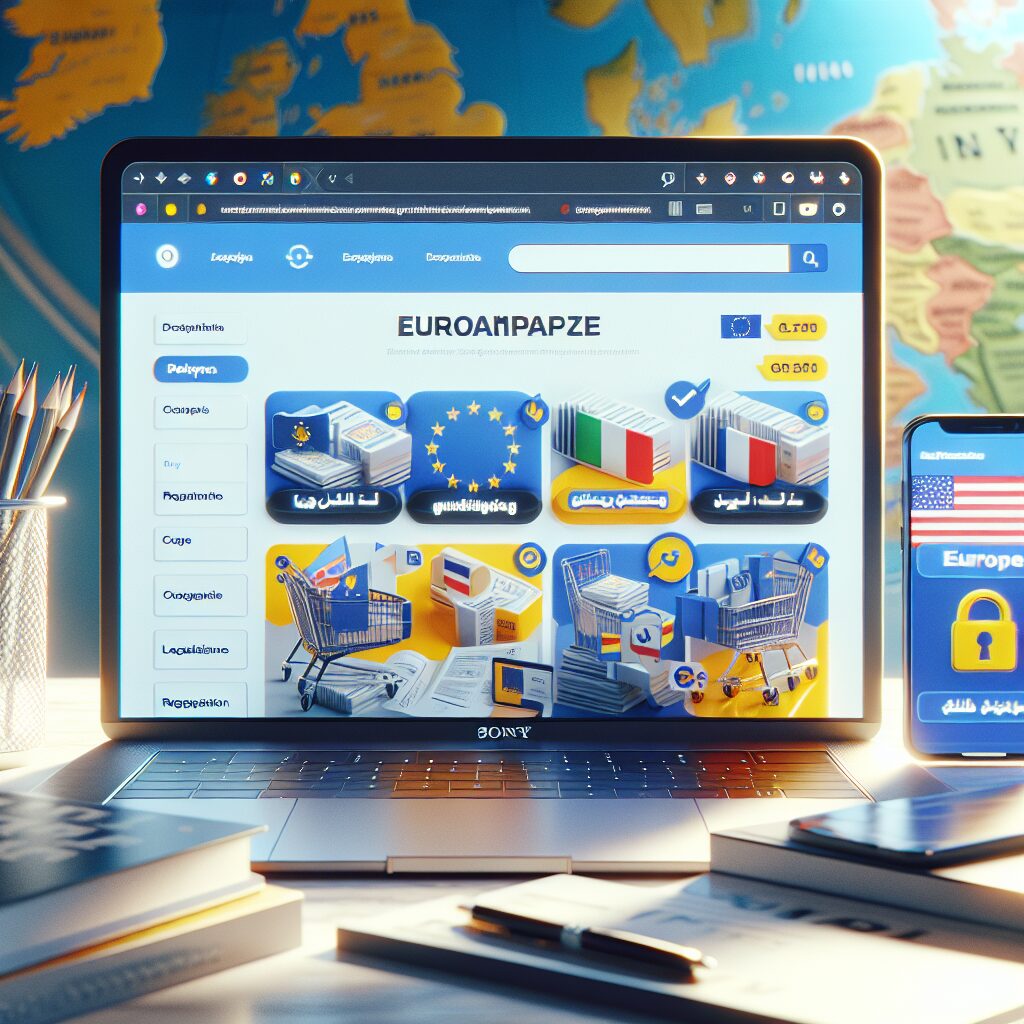About eldris
Clone.Eldris.ai empowers brands to instantly replicate and translate their websites for seamless global expansion. Our automated system delivers SEO-friendly, multilingual clones that launch in days, not months.
In This Article
- EU website compliance demands multilingual legal content under GDPR and DSA laws.
- Speed in localisation ensures fast, profitable market entry in Europe.
- Automated translation tools streamline workflows across ecommerce platforms.
- Top EU languages like German, French, and Spanish should be prioritised for ROI.
- Integrated legal templates and SEO modules simplify ongoing compliance.
- Case studies show localisation can happen in under 48 hours across multiple countries.
- Synchronisation and automated updates are key to long-term compliance.
- Sales activation requires cultural nuance beyond literal translation.
Why EU Website Compliance Matters Now
The importance of multilingual content for regulatory standards
EU website compliance refers to ensuring your website meets the European Union’s strict legal, data, language, and accessibility requirements. These regulations apply not just to companies based within the EU but to any business serving EU residents. Ignoring compliance can result in hefty fines, legal action, or complete market exclusion. A pivotal aspect of compliance is the provision of multilingual content. Under GDPR and evolving regional laws, customers must be informed of their rights, privacy practices, and terms of use in their own language. This mandates that websites provide accurate translations of privacy policies, cookie banners, terms and conditions, consent forms, and relevant disclaimers. Failure to offer this localised content not only violates compliance but undermines user trust.
Moreover, as the EU continues to introduce new Digital Services Act (DSA) and Digital Markets Act (DMA) provisions, scrutiny over digital communications is increasing. Language localisation is now a legal necessity—not merely a courtesy. Organisations entering or operating in this jurisdiction must prioritise website translation workflows and ensure rapid conformity with these changing mandates.

Speed as a Competitive Advantage
Why rapid localisation wins the market entry race
Time-to-market can determine the success or failure of an EU expansion, and speed in localisation is a fundamental accelerator. Particularly for product launches, ecommerce campaigns, and time-sensitive promotions, delayed localisation can render your offering obsolete or cause you to miss valuable seasonal windows. Rapid localisation enables brands to quickly adapt to linguistic and cultural expectations, aligning content with local consumer behaviour.
This agility not only ensures EU website compliance but also enhances brand perception. Businesses that deliver localised experiences from day one position themselves as invested in the market and in the needs of local users. In contrast, those relying on English-only sites alienate audiences and provide incomplete user journeys, reducing sales potential and conversion rates.
“We reduced our EU launch timeline by 75% using automated localisation—every page was not only compliant but culturally relevant.”
Automated Website Translation Tools Explained
Technologies powering fast, scalable localisation
Modern website translation tools harness the power of artificial intelligence, machine learning, and content delivery networks to enable near-instant language replication. Tools like Clone.Eldris.ai automate the end-to-end process—from detecting website content changes to rendering translated pages in milliseconds. These platforms use neural machine translation engines, which are far more accurate and context-aware than legacy systems. Automated workflows integrate seamlessly with CMSs, ecommerce platforms, and code repositories, allowing real-time synchronisation across language variants.
These solutions incorporate built-in compliance checks, enabling teams to stay aligned with EU directives. For example, integrated glossaries ensure that regulatory terms in GDPR or digital privacy laws are translated consistently and accurately. Additionally, translation memory technology allows for the reuse of previously translated content, ensuring efficiency and consistency across product pages, legal pages, and user interfaces. Thanks to these tools, businesses can fulfil EU website compliance mandates at scale and unlock fast-track entry into multiple markets simultaneously.
Localising Legal Pages: Privacy, Terms and More
Complying with GDPR using translation automation
The cornerstone of EU website compliance lies in legal page localisation. GDPR and associated national data laws stipulate that website users must be fully informed, in a language they understand, about how their data is collected and processed. This legal requirement extends to cookie notices, consent forms, terms and conditions, refund policies, and contact information. Merely providing content in English is no longer adequate for compliance in countries like France, Italy, Germany, or Spain.
Translation automation platforms help organisations deploy fully localised legal content efficiently. These platforms often include pre-approved legal templates translated into multiple EU languages. Brands can easily extrapolate these templates across their websites, ensuring uniform legal pages in each local language. This not only achieves compliance but also projects transparency, professionalism, and seriousness of intent to new European users. Using real-time updates, if legal language changes, these platforms can propagate the change across all translated versions without manual intervention.
Top EU Languages to Prioritise for Sales Launch
Choosing markets and translations that deliver ROI
While the EU has 24 official languages, not all offer equal return on investment. Brands launching in the EU should prioritise languages based on commercial opportunity, user base, and localisation readiness. Generally, the top five languages to consider for initial launch include German, French, Spanish, Italian, and Dutch. These markets represent both economic powerhouses and highly digital consumer bases.
Localising into these languages maximises reach while aligning with buyer expectations. German consumers, for instance, demand precision and data transparency, making compliant translated legal copy essential. In Spain and Italy, emotional engagement is crucial, requiring not just translation but cultural adaptation. Analytics from businesses who pioneer localisation indicate that translation into just these five languages can account for over 80% of site traffic from within the EU. Matching translation effort with potential market size unlocks broader reach and boosts cross-border ecommerce conversion.
Shopify, WooCommerce & Other Platform Integrations
Translation automation across ecommerce ecosystems
Integration with ecommerce platforms is key to achieving frictionless EU website compliance. Today’s website translation tools come with plug-and-play modules for platforms like Shopify, WooCommerce, BigCommerce, and Magento. These integrations enable brands to automate translation of product descriptions, checkout flows, customer service messaging, and system-generated emails.
Moreover, localisation platforms maintain dynamic content parity using APIs to detect changes such as newly added product variants or modifications to discount information. When a change occurs, translations are instantly queued, reviewed, and published in the corresponding language versions. This capability maintains compliance for dynamic ecommerce environments where content shifts rapidly. Additionally, ecommerce translations maintain SEO-friendliness through multilingual schema implementation and hreflang tagging, ensuring higher visibility for translated content in local search engines.
Case Study: Expansion Success with Clone.Eldris.ai
How one brand launched to 5 EU countries in 48 hours
Consider the example of a UK-based health and wellness brand aiming to expand into continental Europe using Clone.Eldris.ai. Faced with the challenge of launching into five EU countries—Germany, France, Spain, Italy, and the Netherlands—within just two days, the company leveraged an end-to-end localisation solution. Clone.Eldris.ai automated detection of all translatable content and synced translations in real-time without disrupting their Shopify backend.
The brand used AI-enhanced glossaries to preserve brand tone, legal phrasing, and technical product specifications. Legal pages were instantly localised into the required languages with compliant, audit-ready wording. Within 48 hours, the brand launched all translated websites with fully functioning ecommerce checkouts, translated product descriptions, translated review widgets and compliant cookie banners. In the first week, they saw a 28% increase in region-specific conversions, validating the ROI of fast-tracked, compliant localisation. Learn more about Ecommerce Localisation for EU Expansion
Common Challenges in EU Website Localisation
How to overcome legal and content barriers
Despite advances in localisation tools, businesses often encounter significant hurdles. One of the most persistent challenges is the inconsistency in regulatory interpretation across EU nations. For instance, while GDPR sets a continent-wide standard, local implementation varies. France may require slightly different cookie banner formatting than Germany. Misaligned legal translation can expose a company to legal risk, even if overall intentions were correct.
Another common challenge is maintaining content synchronisation across multiple language domains. When your original content changes, every translation must be updated simultaneously to meet compliance, lest contradictory or outdated information create confusion. Managing this manually is both error-prone and inefficient. That’s why implementing robust translation workflows—with automated detection, real-time publishing, and multi-language QA processes—is vital not just for scaling but for staying compliant in the long term. Read a related article
SEO Best Practices for Multilingual Sites
Maximising discoverability and avoiding cannibalisation
SEO remains vital when launching multilingual sites, and it must be considered early in your EU website compliance strategy. Neglecting multilingual SEO leads to poor visibility and duplicated search listings. Correct implementation involves deploying hreflang tags to signal language and regional intent to search engines, ensuring pages are indexed in the right user geographies.
Avoiding keyword cannibalisation across translations is equally important. Local-language keyword research should drive URL structures, meta descriptions, and headings for each translated version. Automated translation tools that incorporate multilingual SEO modules allow for optimised metadata generation per language. Furthermore, locally hosted subdomains or folders aligned with EU language preferences ensure maximum crawlability and trust from local users and regulators. Harmonising SEO and compliance strategies results in greater discoverability, trust, and higher conversion rates per market. EU official website translation resources
From Translation to Sales Activation
Turning localised content into conversions
While translation addresses comprehension and compliance, true sales activation comes from conversion-centric localisation. This includes translating product-specific trust signals like reviews, guarantees, user guides, and support pages into the target language. More importantly, these must be culturally tuned to reflect local buyer instincts and emotional triggers.
For instance, messaging that builds trust in Germany might focus on TÜV certification or money-back guarantees, while in Italy it may lean on heritage, quality, or personal storytelling. A unified localisation and performance strategy incorporates A/B testing of region-specific language, social proof, and offer positioning. Activating translated pages within paid media campaigns also boosts relevance scores and CTRs. When aligned with EU website compliance processes, sales activation becomes seamless, accelerating market success and justifying the localisation investment. Requirements for EU authorised representative
Conclusion: Expand Smarter, Not Slower
Achieving and maintaining EU website compliance has evolved from a legal checkbox into a strategic advantage. It is no longer sufficient to treat compliance and localisation as post-launch concerns. By integrating automated translation, continuous synchronisation, and multilingual SEO at the planning stage, businesses can dramatically shorten launch cycles while meeting all EU mandates. Speed, precision, and scalability define the next generation of successful European digital expansions. Rather than delaying for manual localisation or risking legal exposure, smart brands build from compliance outward—energising sales faster and creating memorable, localised digital experiences in every EU market they enter.
Great guide on website-translations-fast-eu-compliance-sales-launch – Community Feedback
How do fast website translations help with EU compliance?
Rapid website translations ensure legal content and user experiences meet EU language regulations, minimising compliance risks and penalties. Automated tools help businesses deliver localised privacy policies, terms, and customer journeys.
What are the benefits of launching sales in the EU with a translated site?
Translating your site increases trust, conversion rates, and reduces friction at checkout, enabling faster market entry and reaching a broader European audience.
Which languages are essential for EU ecommerce website translations?
Key EU ecommerce languages include German, French, Spanish, Italian, and Dutch. The best approach is localising for your target markets’ languages and regularly reviewing regulatory updates.










